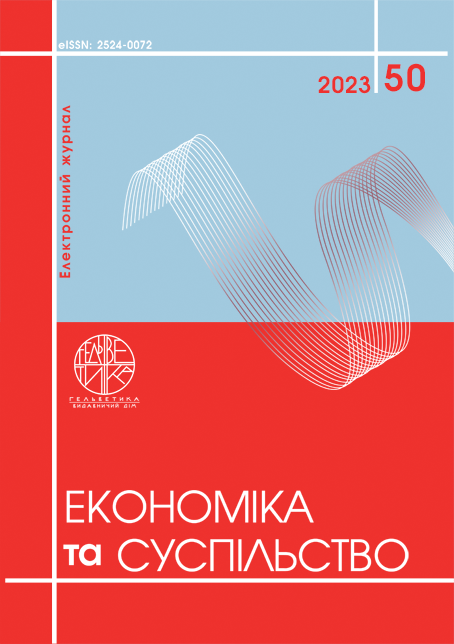EVALUATION OF THE COMPANY'S BRAND BASED ON COMPETITIVE ANALYSIS
Abstract
Brand evaluation based on competitive analysis is extremely important for modern organizations. It allows you to assess the brand's positioning compared to competitors and determine its competitive advantage. This helps to maintain the brand's relevance and relevance in a rapidly changing business environment. Competitive analysis provides an opportunity to understand how the brand relates to other players in the market. Based on the analysis, you can identify the strengths and weaknesses of the brand, as well as the advantages and disadvantages of competitors. This allows you to customize your brand development strategy, improve your products or services, and attract more customers. Brand assessment based on competitive analysis helps to identify new opportunities for growth. This may include expanding the range of products or services, attracting new market segments, or improving the communication strategy. The purpose of the article is to improve the tools for assessing the brand of an enterprise based on competitive analysis and to test it on the example of the beauty salon "PIED-DE-POUL". The study involved the use of scoring methods and analysis to evaluate the brand of an enterprise. Based on the results of the study, the tools for assessing the brand of an enterprise based on a scoring system were improved. The improved toolkit provided for the identification of groups of factors and indicators for assessing the enterprise brand using the D. Aaker brand identity model and the M. Sherrington model; assessment of the relative importance of indicators and the extent of their manifestation in enterprises through expert evaluation; calculation of a weighted score, which is an indicator of brand competitiveness. Using the improved instrumentarium, the strengths and weaknesses in the activities of the beauty salon "PIED-DE-POUL" in comparison with competitors are identified. Weaknesses in the activities of the beauty salon "PIED-DE-POUL" in comparison with its competitor "2ZSTUDIO" are the competence of employees, friendliness, politeness and range of services, comfort of staying in the salon. In order to increase the level of competitiveness, the beauty salon "PIED-DE-POUL" should focus on the services of laser hardware cosmetology, which are not in the assortment of the salon, but are presented in the range of services of the competitor's salon and are in high demand.
References
Головко А.Я. Брендинг в Україні: ґенеза та перспективи. Формування ринкових відносин в Україні. 2008. № 5(84). С. 82–85.
Гриценюк В.В., Руснак А.В., Надточій І.І. Сутність брендингу та його роль у забезпеченні конкурентоспроможності підприємства. Ефективна економіка. 2019. № 12. URL: http://www.economy.nayka.com.ua/?op=1&z=7545
Денисенко М.П., Мельник А.О., Зінорук Л.В. Брендинг як чинник підвищення ефективності діяльності підприємства. Ефективна економіка. 2019. № 11. URL: http://nbuv.gov.ua/UJRN/efek_2019_11_13
Деркач О.Г., Кузьміна А.О. Методичні підходи до формування бренд-орієнтованої системи управління підприємством. Проблеми системного підходу в економіці. 2020. № 5(79). С. 140–147.
Пащенко О.П. Брендинг туристичного підприємства: стратегічний аспект. Економіка і суспільство. 2017. № 9. С. 566–573.
Поплавська В.В. Теоретичні засади та моделі брендингу: облікові аспекти. Вісник ЖДТУ. 2019. № 1. C. 101–108.
Салюк А.П., Холодний Г.О. Формування бренда підприємства: чинники впливу та особливості. Бізнес-інформ. 2018. № 9. С. 265–271.
Харчук О.А. Сутність бренду як економічного поняття: виникнення, становлення та сучасні тенденції розвитку. Економіка. 2016. № 3. С. 414–420.
Нескородєва І.І., Пустовгар С.А. Діагностика банкрутства підприємства з використанням технології факторного аналізу. Фінанси України. 2014. № 7. С. 114–125.
Нескородєва І.І., Чувакова А.А. Удосконалення механізму оцінки кредитоспроможності позичальника банку з використанням метода нечітких множин. Вісник економіки транспорту і промисловості. 2009. № 28. С. 38–47.
Aaker D. Aaker on Branding: 20 Principles That Drive Success Paperback. Morgan James Publishing, 2014. 220 р.
Сегментація аудиторії за допомогою методики 5W Шеррінгтона. URL: https://elit-web.ua/ua/blog/segmentatsija-auditorii-s-pomoschju-metodiki-5w-sherringtona
Holovko A.Ya. (2008). Brendynh v Ukrayini: geneza ta perspektyvy [Branding in Ukraine: genesis and prospects]. Formuvannya rynkovykh vidnosyn v Ukrayini, № 5(84), pp. 82–85.
Hrytsenyuk V.V., Rusnak A.V., Nadtochiy I.I. (2019). Sutnistʹ brendynhu ta yoho rolʹ u zabezpechenni konkurentospromozhnosti pidpryyemstva [The essence of branding and its role in ensuring the competitiveness of the enterprise]. Efektyvna ekonomika, № 12. Available at: http://www.economy.nayka.com.ua/?op=1&z=7545
Denysenko M.P., Melʹnyk A.O., Zinoruk L.V. (2019). Brendynh yak chynnyk pidvyshchennya efektyvnosti diyalʹnosti pidpryyemstva [Branding as a factor in increasing the efficiency of the enterprise]. Efektyvna ekonomika, № 11. Available at: http://nbuv.gov.ua/UJRN/efek_2019_11_13
Derkach O.H., Kuzʹmina A.O. (2020). Metodychni pidkhody do formuvannya brend-oriyentovanoyi systemy upravlinnya pidpryyemstvom [Methodical approaches to the formation of a brand-oriented enterprise management system]. Problemy systemnoho pidkhodu v ekonomitsi, № 5(79), pp. 140–147.
Pashchenko O.P. (2017). Brendynh turystychnoho pidpryyemstva: stratehichnyy aspekt [Branding of a tourist enterprise: a strategic aspect]. Ekonomika i suspilʹstvo, № 9, pp. 566–573.
Poplavsʹka V.V. (2019). Teoretychni zasady ta modeli brendynhu: oblikovi aspekty [Theoretical foundations and models of branding: accounting aspects]. Visnyk ZHDTU, № 1, pp. 101–108.
Salyuk A.P., Kholodnyy H.O. (2018). Formuvannya brenda pidpryyemstva: chynnyky vplyvu ta osoblyvosti [Formation of the enterprise brand: influencing factors and features]. Biznes-inform, № 9, pp. 265–271.
Kharchuk O.A. (2016). Sutnistʹ brendu yak ekonomichnoho ponyattya: vynyknennya, stanovlennya ta suchasni tendentsiyi rozvytku [The essence of the brand as an economic concept: emergence, formation and modern development trends]. Ekonomika, № 3, pp. 414–420.
Neskorodyeva I.I., Pustovhar S.A. (2914). Diahnostyka bankrut·stva pidpryyemstva z vykorystannyam tekhnolohiyi faktornoho analizu [Diagnosis of enterprise bankruptcy using the technology of factor analysis]. Finansy Ukrayiny, № 7, pp. 114–125.
Neskorodyeva I.I., Chuvakova A.A. (2009). Udoskonalennya mekhanizmu otsinky kredytospromozhnosti pozychalʹnyka banku z vykorystannyam metoda nechitkykh mnozhyn [Improvement of the mechanism for assessing the creditworthiness of a bank borrower using the method of fuzzy sets]. Visnyk ekonomiky transportu i promyslovosti, № 28, pp. 38–47.
Aaker D. (2014). Aaker on Branding: 20 Principles That Drive Success Paperback. Morgan James Publishing, 220 р.
Sehmentatsiya audytoriyi za dopomohoyu metodyky 5W Sherrinhtona [Audience segmentation using Sherrington's 5W method]. Available at: https://elit-web.ua/ua/blog/segmentatsija-auditorii-s-pomoschju-metodiki-5w-sherringtona

This work is licensed under a Creative Commons Attribution 4.0 International License.


